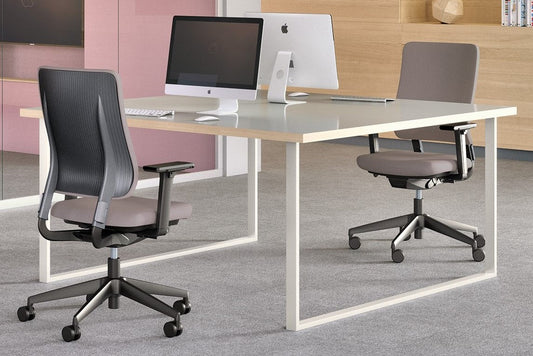Standing Desk Stability: The $64,000 question
Top down, in lots of ways, we’ve worked hard to create a standing desk free from wobble, bounce and vibration. Here’s how we’ve done it.
If you’ve never had a standing desk before, prepare to be initiated into the world of wobble. Wobble is the enemy of sit stand desks. You’ll never notice it when the desk is set to a seating position*. But as those legs extend and the desk rises, wobble is what separates the standing desk stalwarts capable of solidly holding their own, from the wimps. The wimps that wobble.
How Noticeable Is Standing Desk Wobble?
We’ll avoid the ‘it depends on the desk’ answer (even though it does). Wobble is slight. We’re not talking about rocking, rolling and an effect so pronounced you fear your monitors may collapse on you. Wobble is never that bad (and if it is, you really need a better standing desk).
Instead, lets pick a couple of examples of activities where you’ll notice wobble most clearly: typing and Zooming.
Sat at your desk, type a line on your keyboard and watch the screen. See that? Not the slightest shiver. Standing desks, however, have the obvious issue of height to overcome. The better they do it, the less impact there’ll be on your typing and conference calling. Take the FRISKA Stockholm, for example. Even with the legs (masts) extended to their fullest height, typing and calling will still feel an utterly solid experience.
But another standing desk may not give you quite the same sturdiness. The less stable a sit/stand desk, the more vibration each keystroke will create. That might be noticeable as a slight blurring/bouncing of the screen when you type. It may be even more noticeable as you attempt a Zoom call, where your use of the mouse or keyboard may cause the webcam to shift just a touch. It’s rarely much, but it can be noticeable. Usually, the longer you live with it, the more noticeable and irritating it gets.
Does Every Standing Desk Wobble?
Cards on table time. You can’t create a standing desk with absolute zero vibration. Well, you could, but then it wouldn’t be able to move. So the challenge is creating a desk that raises and lowers smoothly but, when set at its loftiest position, ensures any vibration is imperceptible. That’s what we set out to do.
Here are 5 ways we achieved it:

1. Standing Desk Stability – the Legs
A standing desk shifts from a sitting to standing position thanks to telescopic legs, and it’s here that the greatest potential for wobble creation exists. Each section of leg needs to be able to glide almost silently in and out of its housing. Smooth operation of the legs means each section needs to be kept separate from the others. Where parts of the leg assembly are left to grind together you’ll
a) get a much slower rise and fall of the desk
b) experience more noise and
c) burn out your motor because it’s having to work harder than it should.
We achieve that with a plastic insert individually moulded to fit the leg it supports. Because each insert is tailor made, tolerances are as tight as they can possibly be and tight tolerances mean less wobble.
Few standing desk manufacturers go to such lengths. Most use a generic insert for each leg, operating to tolerances of 1mm. That doesn’t sound like much, but consider this. If each leg has three sections and each is out by just 1mm, then by the time your desk is fully extended you’ve got more than half a centimetre of space floating around in your desk frame. And space is where wobble happens.
2. Standing Desk Stability – the Frame
Most standing desks come from the Far East, where manufacturers are rather wedded to a sort of ladder ‘underframe’ on which the desktop sits. Generally speaking these are pretty good and pretty sturdy, but there’s room for cost cutting here. If you’ve seen as many sit/stand desks as we have, you start to notice when the ladder frame looks a little thinner than others, or where the number of fixing points seems a little on the low side. Ten fix points is about average.
We felt we could do better. Rather than the ladder construction, we opted for a u-shaped bar. Actually, ‘bar’ does it something of a disservice. It’s more of a girder, a thumping great expanse of steel strong enough to hold any desktop you place on top of it. And probably some motorway bridges.
Crucially, it’s fixed in place at 20 points, double the average. Which brings us to the next important difference…
3. Standing Desk Stability – the Fixings #1
If you’ve ever assembled some Ikea furniture, you’ll know the first step is usually to screw some chipboard screws into an MFC (melamine faced chipboard) panel that will, at some point in the future, become a wardrobe or bookcase.
Most standing desk manufacturers take a similar approach with their products. But there’s a bit of a problem with that. Left to press on nothing but the inside of the chipboard panel, constant raising, lowering and use of the desk places forces on the screws that will, over time, see the holes widen ever so slightly. That means each screw will be free to wiggle just that fraction of a millimetre more than it once could. Amplified across every screw in your desk, the effect is to notch up the wobble potential, even if only a little.
If you then decide to move your desk, and you disassemble it to reassemble later, you’ll find the act of unscrewing and re-screwing amplifies the effect still further.
In our MFC desks, when we pre-drill a hole we fill it with a threaded metal insert, ready to receive the bolt. Inserting metal screws into metal fixings has two big advantages in addition to the fact that a metal housing is always going to be a more robust option than a chipboard one. There’s no deterioration in the fixing. And when you decide to move your desk, the act of taking it apart and putting it back together again doesn’t affect the integrity of the desk in the slightest. Just remember never to overtighten.
4. Standing Desk Stability – the Fixings #2
While we’re on the subject of fixings, you know what sort of bolts a sturdy standing desk really doesn’t need? Measly, wimpy 5mm bolts that don’t offer the torque strength you ideally need to really ‘weld’ your desks components together.
Despite this, most desks on the market use 5 or 6mm bolts. FRISKA opts for a mighty 8mm, so whether you’re fixing the foot plate to the leg or the leg to the underdesk, every fixing will feel more secure than a Fort Knox vault.
5. Standing Desk Stability – the Feet
If you’re about to invest in a standing desk for its stability, you’d expect no component to let the side down. So why is it so many sit/stand desk companies saddle their products which puny feet? it’s a bit like asking Dwayne Johnson to go stilt-walking on matchsticks.
It’s only a little detail, but our standing desk feet also use 8mm bolts. Robust.

Why Is My Standing Desk Wobbling?
You’ve done the sensible thing and invested in an ultra-sturdy standing desk. But then you start working on it and discover that somehow it just doesn’t feel as stable as you thought it would. It’s certainly not as stable as these customers suggested.
Time to double check a few points:
Address these, and you should banish wobble for good.
A stable standing desk isn’t achieved with a single action. It’s the result of lots of small refinements, each of which may have a small, sometimes barely noticeable effect. But together, they add up to a feeling of rock solid stability.
You get good stability from lots of standing desks. But we believe no desk gives you more stability than a FRISKA.
Discover it for yourself. Explore our full standing desk range here, or for a chat about sturdiness, wobble elimination or anything else, just get in touch.
*Actually, that’s not quite true. Dig around for reviews of a few of our lower priced competitors and you’ll find one or two that can’t even eliminate wobble at a sitting height, but we digress).
Below is a brilliant unsponsored video from Alex at Gear and Tech (https://www.youtube.com/c/AlexGearTech) showing how his old Fully Jarvis desk wobbles badly when in use, compared to his new FRISKA Stockholm desk.
The Stockholm is the most stable height adjustable sit-stand desk available in the world today and whilst it can be made to move a couple of mm at full height if you push to wobble it, this is not noticeable during normal use.
Our reviews from delighted customers speak volumes for testimony of this fact: FRISKA reviews.
There’s also an independent in-depth review from a customer on Reddit which is well worth worth reading: Reddit Review.
Here are some more reasons why ours are the steadiest standing desks on the planet:
It’s worth bearing in mind that cheap imported standing desks often have massive stability problems.





